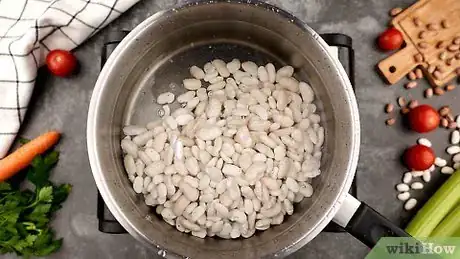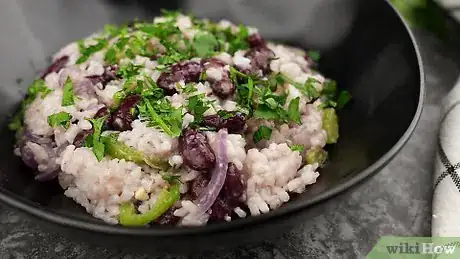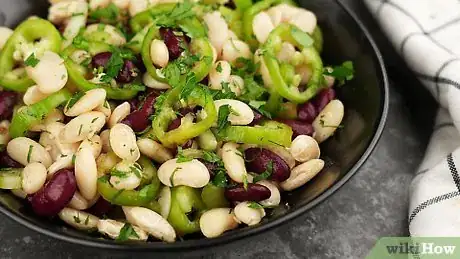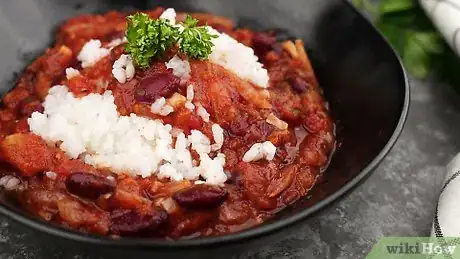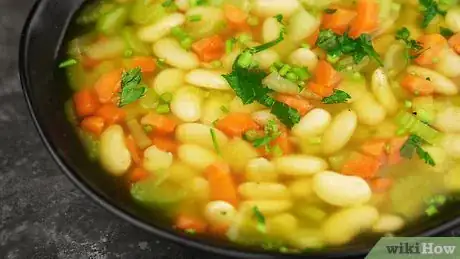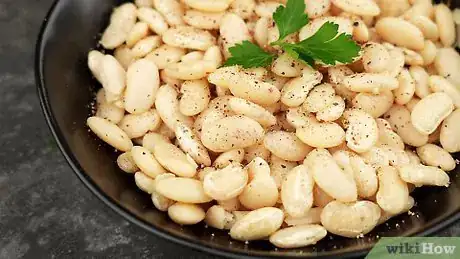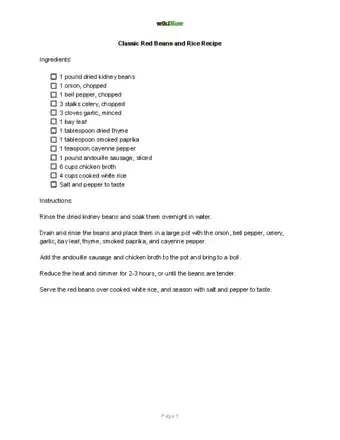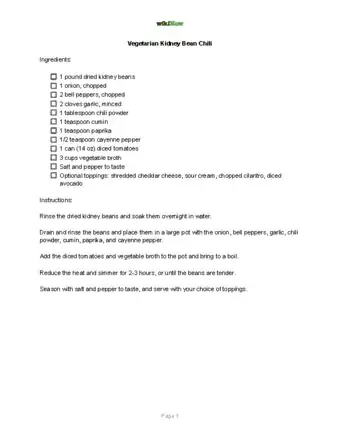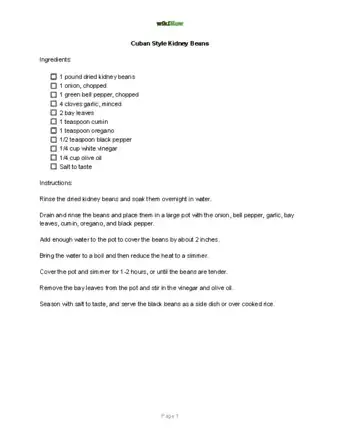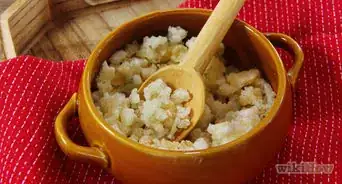This article was co-authored by Marrow Private Chefs. Marrow Private Chefs are based in Santa Rosa Beach, Florida. It is a chefs’ collaborative comprised of an ever-growing number of chefs and culinary professionals. Though regionally influenced primarily by coastal, traditional southern, cajun, and creole styles and flavors, the chefs at Marrow have a solid background in all types of cuisine with over 75 years of combined cooking experience.
wikiHow marks an article as reader-approved once it receives enough positive feedback. In this case, several readers have written to tell us that this article was helpful to them, earning it our reader-approved status.
This article has been viewed 178,755 times.
Kidney beans, also known as rajma, are a staple of Indian cuisine and western cuisine alike. The hearty red kidney bean can be cooked into soups, chilis, and curries, used in salads and rice-based dishes, making it a protein and vitamin-rich meat alternative, or a featured item in its own right. If you want to learn to cooked dried kidney beans properly, you can learn the steps required, as well as what to do with them when you're through.
Steps
Cooking Dried Kidney Beans
-
1Soak dried kidney beans in cold water for 8-12 hours. Dried kidney beans need to be soaked in water before being boiled and cooked. For the best results, soak beans in a pot full of cool water overnight at room temperature.[1]
- It's a good idea to sort through the beans before hand and rinse them off, to remove any dust, sediment, or tiny pebbles that might have gotten mixed in. Rinsing them in a colander is usually fine.
- Without soaking and cooking thoroughly, kidney beans contain phytohaemagglutinin, also known as kidney bean lectin, which causes gastric distress.[2] To avoid this, they need to be cooked at least 30 minutes, at boiling.
- If you don't have the time to soak beans overnight, you can also do the speed-up method. Soak in warm water by bring dry beans to a boil, then turn off the heat and let them soak for about 2-3 hours. Discard the soaking water and cook normally.[3]
-
2Choose a cooking method. Beans are probably most commonly cooked by boiling them in a pot of clean water, on the stove top, for a few hours. There are a variety of ways to cook beans, however, depending on what you have available.
- Another traditional and speedy method is cooking kidney beans in a pressure cooker. Soak the beans normally and lock the lid in place, then follow the instructions for your particular pressure cooker.
- Canned kidney beans do not need to be cooked. You can add them into any recipe that calls for beans without cooking them.
Advertisement -
3Simmer beans gently for 1-2 hours. After soaking the beans, rinse them thoroughly in fresh water and cover the beans with enough clean water to cover them by approximately 2-3 inches. Then, cover the pot and bring the water up to a boil, immediately lowering the temperature and uncovering the pot when the water starts to boil. Cook beans at a very gentle simmer. You want a pot of beans to barely be moving, so they'll cook evenly and as thoroughly as possible.
- Cook the pot with the lid on, but slightly ajar, if you want a creamy pot of beans, and cook uncovered for firmer beans.
- Check the beans after 45 minutes, pulling a few out and squeezing them between your fingers, or try to chew one. After a while, they should be soft and creamy. When they've reached the desired consistency, remove them from the heat.
- Stir the beans periodically to turn them over, ensuring that they'll cook evenly and thoroughly, and make sure the level of the water stays above the level of the beans as much as possible.
- Beans cooked a rolling boil will cook, but they'll split very quickly and become mushier and mealier than beans cooked more slowly and more gently. If you want, you can continue cooking beans for as long as you want, to get the texture you're looking for. Mushy beans are great for dips, curries, and lots of other dishes.
-
4Skim the foam off the top of the pot, periodically. As kidney beans cook, you'll notice a grayish-reddish foam start to appear on the top of the pot. That's the lectin cooking off, and the best thing to do with it is periodically skim it off with a spoon and discard it by rinsing it down the drain.
-
5Add salt and season when the beans are nearly soft. It's very important to cook dried beans unsalted, or the beans will take much longer to cook, and might not actually cook at all. While some varieties of beans will take longer than others, some varieties (like garbanzo beans) will never get fully cooked if they're cooked in salted water.
- At any point in the cooking process, you can add chopped aromatic vegetables. If your recipe eventually calls for onion, garlic, carrots, or other vegetables, you can add them to soften them up at any time. If you'd like the vegetables firmer, add them later in the cooking process. Softer, add them earlier.
- It's also common to add a ham hock or a pork bone of some type to a pot of beans, for added flavor. This is especially common for rice and beans, described in the next section.
-
6Strain the water off the cooked beans, if necessary. Beans are somewhat variable in their cooking time. It's usually common to have to add a little bit of water while the beans simmer away, to keep them cooking evenly. This may result in there being some water left over when the beans are done.
- The general rule of thumb is to add three cups of water for every cup of dry beans you add to the pot. This should theoretically end with a pot of cooked beans and no water.
- It's also common to save most of the liquid in the pot, which can make for a nice gravy. Depending on what you're making with the beans, you won't always have to strain it.
Making Kidney Bean Dishes
-
1Make red beans and rice. Red beans and rice are a classic Cajun dish that's spicy, hearty, and cheap to make. It's perfect for all kinds of add-ins as well, meaning that it's an easy recipe to tweak for your tastes. For a basic version:
- Sauté one small minced red onion, two cloves of garlic, two celery stalks, and a chopped bell pepper in a pot with some olive oil. Stir in about a pound of cooked kidney beans. Alternatively, you could add these vegetables to the kidney beans while they're cooking, as described above.
- To this mixture, add 2.5 cups of water, a cup of white rice, and one ham hock, if desired. Bring the mixture to a boil, reduce the heat to low, and simmer for 20 minutes, covered, until the rice is done. Season with salt, pepper, cayenne, and hot sauce, to taste. Garnish with chopped cilantro.
-
2Make bean salad. Kidney beans make for an excellent and simple chilled salad, which is a great side at any barbecue or cookout. After cooking kidney beans ahead of time, try the following bean salad recipe:
- Mix one cup of kidney beans with one cup of garbanzo beans, one cup of black beans, a cup of chopped bell pepper, and a half cup of chopped green onion.
- Dress the beans in three tablespoons of red wine vinegar, two tablespoons of olive oil, a teaspoon of sugar, a teaspoon of lemon juice, and salt and pepper to taste. Let sit in the refrigerator overnight, then mix thoroughly, and serve cold.
- Any oil-based commercial salad dressing would make for a fine substitution for the vinegar and olive oil, if you prefer. Italian salad dressing works nicely.
-
3Make rajma curry. As you cook a pot of kidney beans, add onions, garlic, and other aromatic vegetables to start the base for this delicious and simple Indian recipe. Rajma is a staple, commonly served with roti or other flat breads. After cooking a pot of kidney beans, in a separate pan:
- Sautee a minced white onion, three cloves of garlic, and a one-inch piece of grated ginger in some ghee. To this, add three small tomatoes, chopped, a teaspoon of cumin seeds, and a tablespoon of ground coriander, a half teaspoon of turmeric powder, and a teaspoon of red chili powder.
- Add your kidney beans directly into the tomato base. Add 2-3 cups of water, or use the liquid from the cooked beans to help thicken. Cook over low heat, uncovered, for 30-40 minutes. Season with salt, pepper, and a teaspoon of garam masala. Serve with rice, roti, or naan, and top with chopped cilantro and lime.
-
4Make chili. A super-common use kidney beans in the United States is to use them in a chili. Whatever variety of chili you favor, kidney beans make a wonderful addition (except in Texas, where it's frowned upon). To make a basic chili:
- Brown one pound of lean ground beef in a pot, adding one minced white onion, three cloves of minced garlic, and 3-4 tablespoons of red chili powder. Cover with 3-4 cups of water, and add 2 cups of cooked kidney beans. Simmer on low, uncovered, for 1-2 hours. Salt, pepper, and hot sauce to taste.
- Other good additions include garbanzos, black beans, corn, and macaroni noodles. Chili goes well with tortillas, corn bread, and baked potatoes.
-
5Make a bean soup. Basic vegetable soup can be lived up with the addition of kidney beans. If you're trying to make a supper that'll clear out the cabinet, a vegetable soup is a great option, and one that you can whip up with a variety of ingredients. For a basic version, try this:
- In a pot, Sauté a minced onion and some garlic in olive oil. Add 1-2 chopped carrots, and a cup of chopped white potato. Add 2-3 cups of chicken/vegetable stock, or water, and simmer. Add whatever vegetables you have on hand: canned, frozen or fresh green beans, corn, and a cup of kidney beans. Season with chopped basil, salt, and pepper to taste.
-
6Just eat them as a side dish. Salted and spiced with a bit of cayenne pepper, kidney beans make for a nice side dish all on their own. Kidney beans are high in Vitamin C, folate, fiber, potassium and protein.[4]
- Need a quick meal? Cook up a pot of beans and a pan of corn bread. Easy and tasty.
Kidney Beans Recipes
Expert Q&A
-
QuestionHow much water do I need to soak beans?
 Marrow Private ChefsMarrow Private Chefs are based in Santa Rosa Beach, Florida. It is a chefs’ collaborative comprised of an ever-growing number of chefs and culinary professionals. Though regionally influenced primarily by coastal, traditional southern, cajun, and creole styles and flavors, the chefs at Marrow have a solid background in all types of cuisine with over 75 years of combined cooking experience.
Marrow Private ChefsMarrow Private Chefs are based in Santa Rosa Beach, Florida. It is a chefs’ collaborative comprised of an ever-growing number of chefs and culinary professionals. Though regionally influenced primarily by coastal, traditional southern, cajun, and creole styles and flavors, the chefs at Marrow have a solid background in all types of cuisine with over 75 years of combined cooking experience.
Private Chefs If you're using dry beans, you need to know that they will expand greatly. For that, make sure to use three times as much water as you have beans.
If you're using dry beans, you need to know that they will expand greatly. For that, make sure to use three times as much water as you have beans. -
QuestionCan red kidney beans kill you?
 wikiHow Staff EditorThis answer was written by one of our trained team of researchers who validated it for accuracy and comprehensiveness.
wikiHow Staff EditorThis answer was written by one of our trained team of researchers who validated it for accuracy and comprehensiveness.
Staff Answer wikiHow Staff EditorStaff AnswerThey’re unlikely to kill you, but they can make you sick if you eat them raw. Raw kidney beans contain a natural chemical that can cause severe vomiting, diarrhea, and abdominal pain. Always cook them thoroughly before eating them.
wikiHow Staff EditorStaff AnswerThey’re unlikely to kill you, but they can make you sick if you eat them raw. Raw kidney beans contain a natural chemical that can cause severe vomiting, diarrhea, and abdominal pain. Always cook them thoroughly before eating them. -
QuestionHow long do kidney beans take to cook?
 wikiHow Staff EditorThis answer was written by one of our trained team of researchers who validated it for accuracy and comprehensiveness.
wikiHow Staff EditorThis answer was written by one of our trained team of researchers who validated it for accuracy and comprehensiveness.
Staff Answer wikiHow Staff EditorStaff AnswerIf you’re cooking dry beans from scratch, it takes 90-120 minutes to cook them on the stovetop. You can cook them faster (about 20-30 minutes) in a pressure cooker.
wikiHow Staff EditorStaff AnswerIf you’re cooking dry beans from scratch, it takes 90-120 minutes to cook them on the stovetop. You can cook them faster (about 20-30 minutes) in a pressure cooker.
Warnings
- It's very important to soak beans thoroughly before cooking them to avoid intestinal distress. Don't attempt to cook and eat dry beans without soaking them and changing the water.⧼thumbs_response⧽
References
About This Article
To cook dried kidney beans, start by soaking them in cold water for 8-12 hours, then rinse the beans off and put them in a large pot. Next, add enough water to cover the beans by 2-3 inches and bring the water to a boil. Then, lower the temperature and simmer the beans for 1-2 hours, periodically skimming off any foam that gathers on top of the water. Add salt and other seasonings once the beans get soft, then drain the excess water and enjoy! For tips on how to use your boiled kidney beans in dishes, read on!
